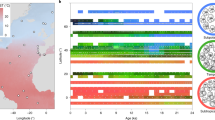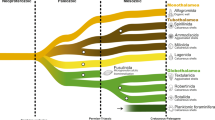Abstract
Recent papers on the evolution of the planktonic Foraminiferida have stressed the importance of repeated patterns1,2 in the Neogene and Palaeogene, as well as in the Cretaceous1–4. Most authors have recognized the importance of gross morphological characters (the biocharacters of Steineck and Fleischer2) and used them to illustrate the evolution of the superfamily Glo-bigerinacea, as well as a prime tool in classification. Cifelli1 and Frerichs4 relate such patterns of evolution to the available palaeotemperature data5, and while temperature is clearly important I shall show that it is not the complete story. Here the evolution of the planktonic Foraminiferida is reconsidered in the light of recent advances in the understanding of distributional controls of the modern fauna. I suggest that well-known ‘iterative’ trends indicate successive attempts at colonizing deeper levels in the water column.
This is a preview of subscription content, access via your institution
Access options
Subscribe to this journal
Receive 51 print issues and online access
$199.00 per year
only $3.90 per issue
Buy this article
- Purchase on Springer Link
- Instant access to full article PDF
Prices may be subject to local taxes which are calculated during checkout
Similar content being viewed by others
References
Cifelli, R. S. Syst. Zool. 18, 154–168 (1969).
Steineck, P. L. & Fleischer, R. L. J. Paleont. 52, 618–635 (1978).
McGowran, B. Micropaleontology 14, 61–80 (1968).
Frerichs, W. E. J. Paleont. 45, 963–968 (1971).
Emiliani, C. Science 154, 851–857 (1966).
Bé, A. W. H. in Oceanic Micropalaeontology Vol. 1 (ed. Ramsay, A. T. S.) 1–100 (Academic, London, 1977).
Douglas, R. G. & Savin, S. M. Mar. Micropaleont. 3, 175–196 (1978).
Hart, M. B. & Bailey, H. W. Aspekte der Kreide Europas (ed. Weidmann, J.) 527–542 (IUGS, Ser. A, No. 6, 1979).
Carter, D. J. & Hart, M. B. Bull. Br. Mus. nat. Hist. (Geol.) 29, 1–135 (1977).
Hart, M. B. & Carter, D. J. J. foramin. Res. 5, 114–126 (1975).
Cooper, M. R. Palaeogeogr. Palaeoclimat. Palaeoecol. 22, 1–60, (1977).
Hancock, J. M. Proc. geol. Ass. 86, 499–536 (1976).
Vail, P. R. et al. Mem. Am. Ass. petrol. Geol. No. 26 (1977).
Hart, M. B. Cretaceous Research Vol. 1 (in the press).
Robaszynski, F. & Caron, M. Cahiers de Micropaleontologie Part 1, 1–185; Part 2, 1–181 (1979).
Masters, B. A. Oceanic Micropalaeontology Vol. 1 (ed. Ramsey, A. T. S.) 301–731 (Academic, London, 1977).
Schlanger, S. O. & Jenkyns, H. C. Geol. Mijnb. 55, 179–184 (1976).
Arthur, M. A. & Schlanger, S. O. Bull. Am. Ass. petrol. Geol. 63, 870–885 (1979).
Jenkyns, H. C. J. geol. Soc. 137, 171–188 (1980).
Degens, E. T. & Stoffers, P. Nature 263, 22–27 (1976).
Thierstein, H. R. & Berger, W. H. Nature 276, 461–466 (1978).
Author information
Authors and Affiliations
Rights and permissions
About this article
Cite this article
Hart, M. A water depth model for the evolution of the planktonic Foraminiferida. Nature 286, 252–254 (1980). https://doi.org/10.1038/286252a0
Received:
Accepted:
Issue Date:
DOI: https://doi.org/10.1038/286252a0
This article is cited by
-
Biostratigraphy of upper Cretaceous planktonic foraminifera in the south Zagros Basin (SW of Iran)
Carbonates and Evaporites (2023)
-
Foraminifera study for the characterization of the Campanian/Maastrichtian boundary in Gebel Owaina, Nile Valley, Egypt
Journal of Umm Al-Qura University for Applied Sciences (2023)
-
Ichnology of the Cenomanian–Turonian boundary event in the southern Tethyan margin (Khanguet Grouz section, Ouled Nail Range, Algeria)
Arabian Journal of Geosciences (2022)
-
Depositional history of the uppermost Albian–Turonian Sarvak Formation in the Izeh Zone (SW Iran)
International Journal of Earth Sciences (2021)
-
Planktonic foraminiferal extinction pattern, evolution, turnover, and geochemical anomalies across the Cretaceous/Paleogene boundary (K/Pg) in Izeh (Zagros Basin, SW Iran)
Arabian Journal of Geosciences (2017)
Comments
By submitting a comment you agree to abide by our Terms and Community Guidelines. If you find something abusive or that does not comply with our terms or guidelines please flag it as inappropriate.



